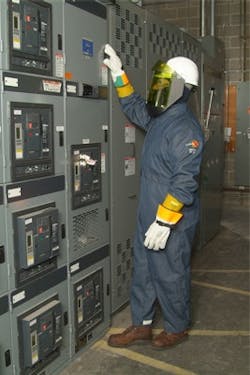Electrical workplace safety training is the best insurance money can buy
In brief:
- Recently, in an effort to improve workplace safety, the industry has begun to focus on protecting workers from the arc-flash and arc-blast hazards that are present when they must perform work on energized electrical equipment.
- NFPA 70E is an industry consensus standard that defines the specific requirements for safely working on or around electrical equipment.
- One of the most fundamental safety requirements for electrical workers is to turn off the power to the equipment before they attempt to work on it.
Serious workplace injuries and fatalities from electrical arc flash incidents have been occurring ever since electrical energy was first generated and distributed for productive applications. Arc flash accidents that result in a serious injury or fatality occur five to 10 times a day in the United States. Approximately once per day a worker involved in an electrical accident does not survive. Recently, in an effort to improve workplace safety, the industry has begun to focus on protecting workers from the arc-flash and arc-blast hazards that are present when they must perform work on energized electrical equipment.
Figure 1. NFPA 70E defines specific safe work practices and personal protective equipment (PPE) for workers to help protect them from these hazards. (Source: Oberon Company)
One of the results of that focus has been the development and publication of NFPA 70E — Standard for Electrical Safety in the Workplace. NFPA 70E is an industry consensus standard that defines the specific requirements for safely working on or around electrical equipment. OSHA recognizes the NFPA 70E standard as a written, published standard, available to the industry, and it cites the requirements of this standard for employers. NFPA 70E is updated every four years. It defines specific safe work practices and personal protective equipment (PPE) for workers to help protect them from these hazards (Figure 1). OSHA recognizes this important document and will use these requirements to determine compliance for employers regarding electrical workplace safety.
An arc flash results from a short circuit or fault condition that occurs when the insulation between energized electrical phase conductors, or between a phase conductor and ground, is somehow compromised. The other type of major electrical fault is called a “bolted fault.” During a bolted fault, the fault current normally flows over a conductive path and is not usually released outside of that path. While such faults can be damaging, little energy is released into the surrounding environment during the fault, and an upstream overcurrent protective device will respond rapidly to open the faulted circuit.
During an arcing fault however, the fault current flows through the air rather than through a conductor or other conductive component, and a great deal of thermal energy is released into the environment. This sudden release of thermal energy, similar to that seen in an electrical arc furnace, is referred to as an arc flash event. As a result of the sudden release of energy, a pressure wave also develops and expands outward at a high velocity. This pressure wave is usually called arc blast when it is a result of an arc flash event. Arc blast is another human hazard that may cause serious injury, and workers must be protected from it, as well.
The degree of arc flash hazard is measured by the incident energy that is released, which is expressed in calories or joules per square centimeter. This incident energy defines the thermal exposure that a worker standing at a certain distance from the source of the arc (the “working distance”) would expect to receive on the head and torso. In addition to the thermal energy release, there are other hazards produced by these events, including arc blast (a high-pressure wave), sound levels that can lead to permanent hearing damage, and often a ballistic threat from high-speed flying particles and objects.
The incident energy level at a given location in an electrical system is dependent on many factors, such as system voltage and component impedance, available fault current, and the arcing fault duration. The faster an arcing fault is detected and cleared from the system, the less energy it releases into the air, so the action of the overcurrent protective device — specifically, how quickly it can detect and clear the fault — is a critical parameter in determining the level of arc flash hazard in a given system. In fact, in most cases the fault clearing time is the only variable in the equation that can reasonably be controlled in order to limit the incident energy that will be produced by an arcing fault.
The human damage and financial costs that result from arc flash accidents can be very significant. It is estimated that a serious accident from which the victim survives will on average cost more than $10 million, which is a combination of direct and indirect costs. Some very serious accidents have resulted in much higher costs. The victim often suffers permanent and disfiguring physical trauma that shortens the life span and prevents them from ever returning to work. This is a serious risk not only to the worker and the worker’s family, but to the employer and its insurers. For small employers, the company itself may not survive.
De-energized for safety
One of the most fundamental safety requirements for electrical workers is to turn off the power to the equipment before they attempt to work on it. This is usually done through a documented process called lockout/tagout (LOTO). Obviously, electrical equipment, or any other type of equipment, that has been safely disconnected from its energy source is no longer a threat to the worker from any possible electrical or other kinetic energy exposure. But sometimes, turning off the power is not a reasonable option, especially if doing so might actually cause a safety hazard in another way.
An unfortunate series of preventable errors
Electrical accidents that cause human injury and fatality almost always are initiated by some unintentional human error and almost always result from an unfortunate series of preventable errors. Electrical equipment is designed to operate safely and reliably throughout its service lifetime, often for several decades. It is very rare for electrical equipment to fail spontaneously, even when it suffers abuse from long-term maintenance neglect. When these rare failures do occur, there is usually no person standing near the equipment, so the equipment is often damaged or destroyed but no one is involved or injured in the event.
When the accident results in an injury or fatality or even a “near miss,” the initiating cause is usually some error by the worker. Accidents are never a result of an intentional act. Electricians never leave home in the morning and say, “Honey, I am going to do something really dangerous today, and I might not be coming home.” Electrical accidents always result from a lack of awareness of safe work practices, which can also be stated as a lack of training.
Safety training
Figure 2. From a risk-management perspective, safety training is a cost-effective strategy an employer can provide to employees exposed to workplace hazards.
Safety training for a “qualified person,” which is required by the standards, is one of the most important requirements for workplace safety, and especially electrical workplace safety (Figure 2). It is also the easiest compliance requirement for employers to implement, and perhaps the least costly, as well. From a risk management and safety perspective, safety training is probably the most cost-effective strategy that an employer can provide to its employees who may be exposed to workplace hazards. Many of the other contributing factors that might lead to an accident are existing substandard conditions or substandard practices. The human error factor is simply the initiator when the accident involves an employee.
Most other types of accidents involve the same common causality — that is, human error is, in most cases, the most significant contributing factor to the accident. For example, a study on motor vehicle accidents, the Indiana Tri-Level Study, done in 1979 concluded that 90.3% of motor vehicle crashes involved some type of at-risk driver behavior. The vehicle was designed to be safe to operate, but the safety variable factor was the behavior of the driver. For those of us who drive motor vehicles, that is probably not a very surprising statistic. It is true that even with motor vehicle accidents there are usually multiple causes that culminate in the accident.
Hazard elimination
Figure 3. The first line of defense against human behavior is training.
Most companies recognize that equipment modifications can help to improve safety. These things are relatively easy to identify and address by the employer who cares about workplace safety. Machine safeguarding is an example of what OSHA terms as an “Engineering Control.” Machine safeguarding can prevent a worker from being injured by a machine. Reducing hazards to the greatest extent possible by “engineering them out” is an excellent first-step approach, and eliminating an electrical or other kinetic machine hazard is even better. However a worker’s unsafe behavior is likely to be the most important variable to identify and correct.
Joseph Weigel is owner of Electrical Safety Works, a Nashville, Tennessee-based consulting business that specializes in providing electrical workplace safety and legal support services to clients. He has authored and published more than100 expert articles in various electrical and safety trade publications and has lectured extensively. Contact him at [email protected].
Charlie Palmgren is a senior management consultant and executive coach, as well as a Nashville, Tennessee-based partner and facilitator with Innovative InterChange. Palmgren has authored two books, “The Chicken Conspiracy” and “Ascent of the Eagle.” Contact him at [email protected].
The first line of defense is to address the human behavior, and the key to that is training (Figure 3). Other activities that comprise a good safety management control system involve observation of current work practices, identifying safety vulnerabilities, and eliminating or correcting them. Recognizing these factors, most companies that are serious about workplace safety now rely on safety management systems that approach the problem from multiple perspectives, and the most important of these system components is called “behavioral safety.”
Blame the victim
Unfortunately, companies that have not developed good safety management systems, often default to a “blame the victim” safety management strategy. I worked for a company many years ago that believed, if an employee was injured in an accident, that employee should be fired immediately for gross negligence in performing duties. The company’s senior management felt that blaming the victim would deflect responsibility away from its own failure to manage and provide a safe workplace and also would help to create a more defensible legal position when the inevitable litigation ensued. This strategy often had unintended consequences when juries decided settlements for the injured employee. Juries and regulatory agencies today do not look favorably on such practices, and we see less and less of this today, in favor of a serious safety management effort.
The new paradigm
Neither blaming the victim nor blaming management is very useful. In the new paradigm of loss control only those analysis tools that blame neither the victim nor the management are utilized. The new paradigm needs management and workers together to accept their responsibilities jointly and to work together to find the underlying real causes of accidents or other “undesired events.” In fact, we need to go from blame to accountability.






